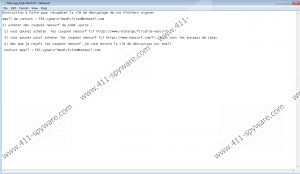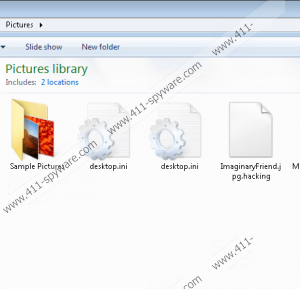Gendarmerie Ransomware Removal Guide
The Gendarmerie ransomware is a damaging computer infection targeted at French-speaking computer users. The threat gets on the computer surreptitiously and encrypts files so that they are not longer accessible. The Gendarmerie threat also creates ransom messages; hence the name of its category. It is highly advisable to disregard the attacker's requirements to submit a release fee, because this threat is another profit-oriented infection whose creators are not interested in restoring their victims' data. As soon as the Gendarmerie ransomware, or rather its damage, is noticed, it is important to act immediately to remove the infection. The fact that the threat is present on the PC indicates that your OS needs protection against malware, and the longer you wait, the more you risk.
The Gendarmerie scans all the system for different types of files to encrypt them. After encoding a file, the infection adds a new extension to the existing one. For example, a Word document affected by Gendarmerie has two extensions that are .doc.hacking. Additionally, every folder in which encrypted files are located also gets a file containing information about the encryption. The file is named Message_Important so that the victims can find out about the situation as soon as they open any folder. The ransom message is given in a .txt file, which has recently become a feature of ransomware infections. A few year ago, a typical ransomware threat would lock the screen by showing a full-screen warning containing a so-called ransom warning. The latest infections lack this feature, which suggests that it is much faster to write a ransom note in a notepad file than program a full-screen warning. In this way, black hats can immediately launch their extortion campaign.
The Gendarmerie ransomware is build on the open source program Hidden Tear, which is available to everyone interested in building ransomware. Hidden Tear was created for educational purposes and uses AES encryption, which is also known as symmetric encryption. Shortly after releasing this open source, interested people acquired it for creating new threats. Initially, this ransomware building program was able to encrypt files that are located in a test directory, which would mean that no serious damage is made. However, this drawback of the code was fixed by launching Trojans that encrypt files that are located in other directories.
The Gendarmerie ransomware requires a specific sum of money unlike some recently detected ransomware threats. According the ransom warning, the victim has to pay a sum of 100 Euros in Neosurf, which is a prepaid card system enabling clients to make safe online payments without using their banking details. In order to pay make a payment in Neosurf, the victim is supposed to purchase a Neosurf voucher worth €100. Each voucher has a unique pincode which is used to make a payment. After purchasing a Neosurf voucher, the victim is required to send the code to fbi-cybercrimedivision@hotmail.com. The email name is made to look as if the demand was made by the Federal Bureau of Investigation, which is another forgotten strategy used a several years ago. No law enforcement institution would ever try to obtain your money in this. Instead of paying up, take action to remove the Gendarmerie ransomware. Moreover, you should take some preventative measures to avoid or fight off malware attacks.
In order to minimized the risk of getting the PC infected, it is advisable to bypass software sharing websites and ignore questionable emails and their attachments. Moreover, it is important to keep the operating system updated. Malware may find its way to a PC through some vulnerability in software, which should also be updated whenever it is possible. On top of that, keeping the OS secured against malware by a reputable security tool is extremely important. There are multiple types of malware, which are spread differently, and their payloads differ. Hence, it is physically impossible to fight against malware manually. For this reason, we advise implementing our recommended tool.
In case you are determined to remove the Gendarmerie ransomware manually, the guidelines given below should help you. If you should happen to have any difficulty with the removal of Gendarmerie, feel free to leave your query in the comment box.
How to remove the Gendarmerie ransomware
- Look at the contents of the desktop to find any questionable files downloaded recently.
- Delete suspicious-looking files.
- Use the shortcut Win+E and type in Downloads.
- Check your recently downloaded files and delete anything questionable.
- Use the same shortcut to check the temp directory.
- Empty the Recycle bin.
Gendarmerie Ransomware Screenshots:



